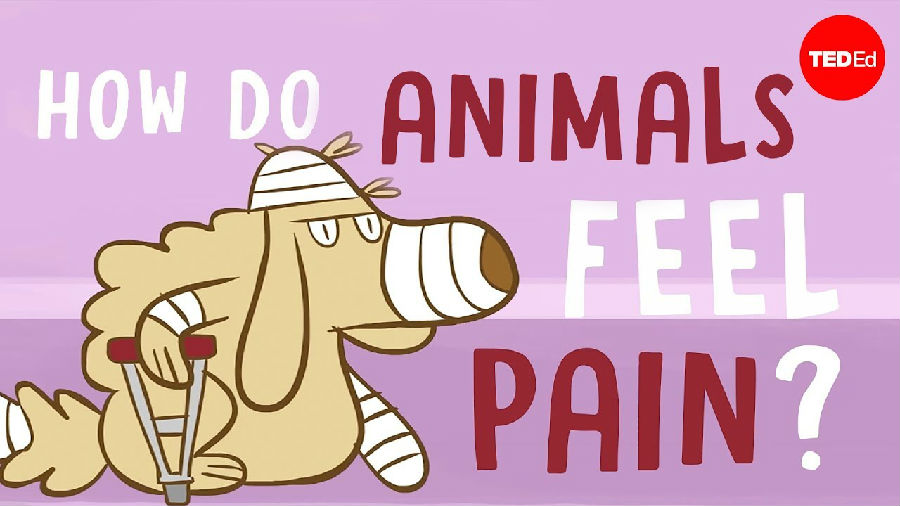(单词翻译:单击)
Humans know the surprising prick of a needle, the searing pain of a stubbed toe, and the throbbing of a toothache.
人类知道被针扎、不小心踢到脚趾的剧痛,还有一阵阵牙痛。
We can identify many types of pain and have multiple ways of treating it.
我们可以分辨多种疼痛,也有很多种解决的办法。
But what about other species? How do the animals all around us experience pain?
那么其他物种呢?我们身边的动物如何感知疼痛?
It's important that we find out.
了解这些非常重要。
We keep animals as pets, they enrich our environment, we farm many species for food,
我们把动物当作宠物,它们丰富了我们生活的环境,我们饲养动物作为食物,
and we use them in experiments to advance science and human health.
我们用动物做实验,去探究科学和人类健康。
Animals are clearly important to us, so it's equally important that we avoid causing them unnecessary pain.
显然,动物对我们很重要,那么同样重要的是避免让它们感到不必要的疼痛。
For animals that are similar to us, like mammals, it's often obvious when they're hurting.
像那些和我们相似的动物,比如哺乳类动物,它们感受到痛苦往往显而易见。
But there's a lot that isn't obvious, like whether pain relievers that work on us also help them.
但也有很多并不易察觉,就像我们并不知道我们的止痛药能否帮助动物?
And the more different an animal is from us, the harder it is to understand their experience.
当动物与我们的区别越大,我们会更难明白它们的感受。
How do you tell whether a shrimp is in pain? A snake? A snail?
你怎么知道一只虾正感到疼痛?那么一条蛇呢?一只蜗牛呢?
In vertebrates, including humans, pain can be split into two distinct processes.
对于包括人类在内的脊椎动物,痛觉可以分为两个截然不同的过程。
In first, nerves and the skin sense something harmful and communicate that information to the spinal cord.
首先,神经和皮肤感受到伤害,并把这个信息传递给脊髓。
There, motor neurons activate movements that make us rapidly jerk away from the threat.
于是,运动神经元激发让我们快速远离危险的动作。
This is the physical recognition of harm called nociception,
这种身体上的伤害识别,被称为“伤害感受”,
and nearly all animals, even those with very simple nervous systems, experience it.
几乎所有动物,即使是神经系统非常简单的动物,都有伤害感受。
Without this ability, animals would be unable to avoid harm and their survival would be threatened.
如果没有伤害感受,动物则不能避免伤害,同时它们的生存也会受威胁。
The second part is the conscious recognition of harm.
第二部分是有意识的伤害识别。
In humans, this occurs when the sensory neurons in our skin make a second round of connections via the spinal cord to the brain.
对于人类,这涉及皮肤里的感觉神经元经过脊髓第二次连接到脑部。
There, millions of neurons in multiple regions create the sensations of pain.
百万个神经元分布于不同的区域,产生疼痛的感觉。
For us, this is a very complex experience associated with emotions like fear, panic, and stress, which we can communicate to others.
这其中的情绪体验非常复杂,包含害怕、慌张和压抑,我们可以与其他人交流这些感受。
But it's harder to know exactly how animals experience this part of the process because most them can't show us what they feel.
但是我们很难知道动物如何体验这一部分过程,因为大部分动物不能向我们表露它们的感受。
However, we get clues from observing how animals behave.
但我们可以从观察动物行为中找到线索。

Wild, hurt animals are known to nurse their wounds, make noises to show their distress, and become reclusive.
我们知道野生动物会护理它们的伤口,发出声音表达它们的悲痛,以及离群独处。
In the lab, scientists have discovered that animals like chickens and rats will self-administer pain-reducing drugs if they're hurting.
科学家通过实验发现,像鸡和老鼠这些动物,如果受伤,它们会给自己服用止痛药。
Animals also avoid situations where they've been hurt before, which suggests awareness of threats.
动物也会避免曾经受伤的环境,这证明了动物能意识到危险。
We've reached the point that research has made us so sure that vertebrates recognize pain
研究也向我们证实脊椎动物能识别疼痛,
that it's illegal in many countries to needlessly harm these animals.
因此在很多国家伤害动物是违法的。
But what about other types of animals like invertebrates?
但其他种类的动物,比如无脊椎动物,又会如何呢?
These animals aren't legally protected, partly because their behaviors are harder to read.
这些动物不被法律保护,一部分是因为它们的行为更难读懂。
We can make good guesses about some of them, like oysters, worms, and jellyfish.
我们可以猜测一些无脊椎动物的行为,例如牡蛎、蠕虫和水母。
These are examples of animals that either lack a brain or have a very simple one.
这些都是没有大脑的动物,或是脑部结构很简单。
So an oyster may recoil when squirted with lemon juice, for instance, because of nociception.
牡蛎在被柠檬汁喷射后快速畏缩,因为它有“伤害感受”。
But with such a simple nervous system, it's unlikely to experience the conscious part of pain.
但由于它们神经系统很简单,它们不太可能有意识地感受疼痛。
Other invertebrate animals are more complicated, though, like the octopus,
其他无脊椎动物则更加复杂,例如章鱼,
which has a sophisticated brain and is thought to be one of the most intelligent invertebrate animals.
它有一个复杂的脑部,它被认为是无脊椎动物中智力最高的物种之一。
Yet, in many countries, people continue the practice of eating live octopus.
然而在很多国家中,人们依旧生吃章鱼。
We also boil live crawfish, shrimp, and crabs even though we don't really know how they're affected either.
我们也会煮活的小龙虾、海虾和螃蟹,尽管我们并不知道它们的感受。
This poses an ethical problem because we may be causing these animals unnecessary suffering.
这就引申出了一个道德问题,因为我们可能会对这些动物造成不必要的伤痛。
Scientific experimentation, though controversial, gives us some clues.
科学实验虽有争议,但给了我们很多线索。
Tests on hermit crabs show that they'll leave an undesirable shell if they're zapped with electricity but stay if it's a good shell.
寄生蟹在试验中被电击之后会离开损坏的外壳,但如果是一个完好的壳,它们会继续待在里面。
And octopi that may originally curl up an injured arm to protect it will risk using it to catch prey.
章鱼会卷起受伤的触手来保护自己,也会在捕猎时冒险使用受伤的触手。
That suggests that these animals make value judgements around sensory input instead of just reacting reflexively to harm.
这说明这些动物能在感官接受之后做出判断,而不只是对伤害做出反应。
Meanwhile, crabs have been known to repeatedly rub a spot on their bodies where they've received an electric shock.
同时,螃蟹在受到电击后会反复摩擦身体受电击的部位。
And even sea slugs flinch when they know they're about to receive a noxious stimulus.
即便是海参也会在受到有害刺激后蜷缩。
That means they have some memory of physical sensations.
这说明它们对生理感觉有记忆。
We still have a lot to learn about animal pain.
关于动物的痛觉,我们还有很多需要学习。
As our knowledge grows, it may one day allow us to live in a world where we don't cause pain needlessly.
随着我们知识的增长,或许将来我们可以生活在一个没有不必要伤痛的世界。


